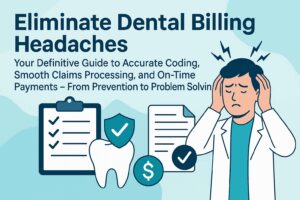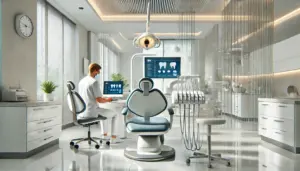
Engage, Educate, Excel: Mastering Patient Communication in 2025 Dental Practices

Key Points
- Strong communication boosts retention: Research suggests dental practices with effective two-way communication experience up to a 25% increase in patient retention, fostering loyalty and trust.
- Poor communication leads to loss: Approximately 27.7% of patients switch dentists due to inadequate interactions, highlighting the need for clear, empathetic engagement to avoid dissatisfaction.
- Technology enhances efficiency: In 2025, trends like AI-driven tools and two-way texting can improve engagement, with text messages boasting a 98% open rate compared to 20% for emails.
- Personalization matters: Tailoring approaches to diverse populations, including children and cultural groups, builds stronger relationships, though barriers like time constraints and low health literacy persist.
- Balanced empathy prevents burnout: While empathy is key, strategies for self-care are essential to avoid fatigue, ensuring sustained high-quality care.
Why Patient Communication Drives Practice Success
Effective communication is the cornerstone of thriving dental practices, directly impacting patient satisfaction, treatment acceptance, and revenue. Studies show that clear interactions lead to better outcomes, with satisfied patients more likely to adhere to plans and refer others. For instance, practices prioritizing rapport see improved loyalty, while neglecting it risks losing patients amid rising competition.
Top Strategies for Improvement
Implement active listening by thanking patients for feedback and addressing concerns promptly, which builds trust. Use visual aids and simple language for education to empower decisions. Leverage technology like patient portals for reminders and follow-ups, aligning with 2025 trends in digital engagement. Adopt a person-centered approach to respect individual needs, enhancing compliance.
Industry Trends in 2025
With AI adoption growing, practices are using automated tools for scheduling and communication, reducing missed calls (average 300 per month) and boosting efficiency. Personalized messaging via preferred channels increases confirmation rates, as per recent reports.
Improving Patient Communication in Dental Practices: The Key to Success
In the fast-paced world of dentistry, where clinicians and team members often focus on procedural efficiency, patient communication remains a pivotal yet sometimes overlooked element. Building robust connections not only enhances retention—studies indicate a 25% increase in patient loyalty for practices emphasizing two-way dialogue—but also drives productivity and long-term success. As the dental industry evolves in 2025, with trends like AI integration and personalized engagement on the rise, prioritizing communication is essential for delivering exceptional care and fostering enduring relationships. This comprehensive guide draws on industry insights, research, and best practices to help dental professionals elevate their interactions.
Building Rapport: The Foundation of Effective Communication
Dentists frequently immerse themselves in clinical tasks, but stepping back to build rapport can transform patient experiences. Engaging in genuine conversations about families, work, or oral health goals signals care beyond the procedure. According to a literature review on dentist-patient communication, creating an open environment encourages questions and boosts satisfaction. In practice, this means starting appointments with eye contact, smiles, and personalized greetings—fundamentals that align with the Nova Scotia Dental Association’s guidelines, where 4 out of 5 public inquiries could be resolved through better initial rapport.
Industry data from 2025 highlights that rapport-building reduces anxiety, particularly amid a hygienist shortage affecting nearly 40% of practices. For example, platforms like Axle Dental use AI to centralize patient data, enabling personalized interactions that enhance trust and retention.
Encouraging Questions: Empowering Patients in Their Treatment Decisions
Patients often hesitate to voice concerns post-recommendation, yet fostering an inquisitive environment leads to informed choices and higher acceptance rates. Pose open-ended questions like “How does this align with your oral health goals?” to invite dialogue. Research shows that encouraging feedback improves understanding and satisfaction, with practices using such techniques seeing better adherence.
In 2025, amid rising teledentistry adoption (projected to grow 20% over five years), virtual consultations provide additional opportunities for questions, reducing barriers like fear, which affects 22% of patients avoiding visits. Tools like Intiveo’s patient engagement software optimize confirmation rates by timing communications effectively, ensuring patients feel empowered.
Active Listening: Valuing Patient Complaints and Feedback
Dismissing complaints risks eroding trust; instead, listen attentively, thank the patient, and commit to solutions. This empathetic approach, per CDA guidelines, turns feedback into improvement opportunities and retains patients. A Jordanian study found that active listening, including eye contact and emotional acknowledgment, significantly influences compliance and outcomes.
With 27.7% of adults switching dentists due to poor communication, practices must prioritize this. In 2025, AI call centers capture missed calls (up to 300 monthly per practice), allowing follow-ups that demonstrate attentiveness.
Education: Empowering Patients with Knowledge
Educating patients on oral health and treatments fosters engagement. Use visual aids like intraoral images, radiographs, and videos to explain consequences of inaction. Planet DDS insights emphasize that patient-centered education, avoiding jargon, reduces anxiety and boosts adherence. Statistics reveal untreated caries affect 46% of children aged 2-19, underscoring the need for proactive education.
Emerging 2025 trends include AI-driven X-ray analysis for personalized education, improving case acceptance by highlighting needs like periodontal therapy.
Efficient Communication: Making Time for Patients
Delays are common, but transparency—informing patients of wait times and offering rescheduling—respects their time. Best practices recommend preconditioning via websites or referrals to set expectations, shortening consultations. Automated reminders, used by 49% of practices, cut no-shows and enhance efficiency.
In 2025, digital tools like text-to-pay reminders streamline processes, aligning with patient demands for convenience.
Person-Centered Approach: Treating Patients as Individuals
Inquire about personal circumstances affecting oral health, remembering details for follow-ups. This builds relationships and provides insights into compliance factors. A person-centered model increases satisfaction, as patients feel valued beyond their dental needs.
With diverse populations, cultural sensitivity is key; barriers like low health literacy affect outcomes, but tailored approaches mitigate this.
Setting an Agenda: Collaborative Treatment Planning
Jointly prioritize concerns to align recommendations with patient goals. Collaborative planning optimizes outcomes and satisfaction, per research. In pediatric care, explaining limitations to guardians ensures informed consent.
Respecting Patient Expertise: A Collaboration of Knowledge
Acknowledge patients’ lifestyle insights for personalized plans. Soliciting input increases compliance, with trust communication directly enhancing satisfaction.
Preventing Empathy Fatigue: Balancing Compassion and Self-Care
Empathy is vital but can lead to burnout; self-care strategies and technologies like pain management programs help. Positive dentist-hygienist communication reduces patient fear and improves health.
Tailoring Communication to Diverse Populations
Adapt styles—empathy for some, visuals for children—to meet needs. California studies show providers use few techniques, but training bridges gaps.
| Communication Technique | Benefits | Supporting Statistic |
|---|---|---|
| Active Listening | Builds trust, improves feedback | 73.3% of dentists lack formal training, but it boosts satisfaction |
| Visual Aids | Enhances understanding | Used in education, reduces anxiety in 83% of cases |
| Two-Way Texting | Increases engagement | 98% open rate, drives confirmations |
| Teach-Back | Ensures comprehension | Infrequently used (less than 25%), but improves adherence |
| Personalized Follow-Ups | Boosts retention | AI tools reduce missed calls by capturing 300/month |
Utilizing Technology: Enhancing Communication
Digital platforms like portals and AI chatbots streamline reminders and education. In 2025, AI market reaches $36 billion, with tools like Heynia automating scheduling. Adoption of automated RCM verifies benefits, freeing time for interactions.
Conclusion
Enhancing patient communication through rapport, education, and technology is crucial for success in 2025’s evolving landscape. By addressing barriers and leveraging trends, practices can achieve higher satisfaction, retention, and growth.
Are you looking for a reliable partner to handle your dental billing needs? Consider One Dental Billing, a leading dental billing outsourcing company in the USA. With our expertise and commitment to excellence, you can focus on providing exceptional patient care while we streamline your billing processes. Contact One Dental Billing today to maximize your revenue potential. Visit One Dental Billing for more.
Key Citations
- Strategies for Effective Dentist-Patient Communication: A Literature Review
- An Overview of Dentist–Patient Communication in Quality Dental Care
- Patient Communications: A Guide for Dentists (PDF)
- Improving Patient Communication in Dental Practices
- Positive communication in the dental practice reduces risk
- Mastering dental patient communication
- Mastering the Art of Patient Communication in Dentistry (PDF)
- Rating communication skills in dental practice
- Dental Patient Communication: Tips for a Successful Outcome
- Strategies to Elevate Dental Patient Engagement
- Mastering Patient Communication for a Thriving Dental Practice
- Top 7 Dental Practice Marketing Statistics
- How to Improve Dental Office Patient Experiences
- The Importance of Effective Communication in Dental Case Acceptance
- Do’s and Don’ts of Effective Dental Patient Communication
- 6 Dental Insights from Q2 2025
- 2025 Global Dental Industry Insights
- 2025 Dental Industry Outlook (PDF)
- Enhancing patient treatment outcomes through effective dentist-hygienist communication
- Top Dental Industry Trends for 2025
- Patient Communication Trends 2025
- 2025 Dental Patient Engagement Report
Contact Us
Phone: 908-357-1515
111 Town Square Pl, Suite 1203 Jersey City, NJ 07310












